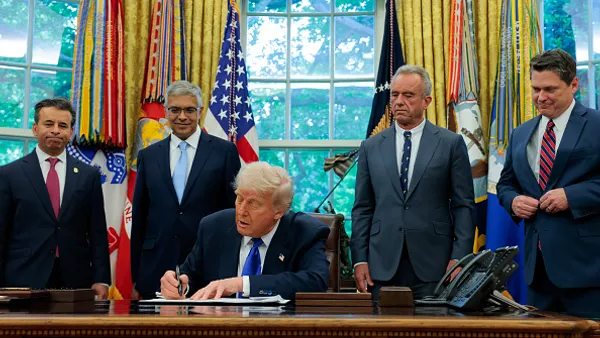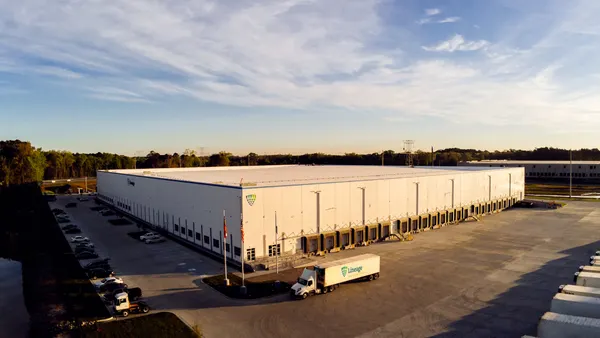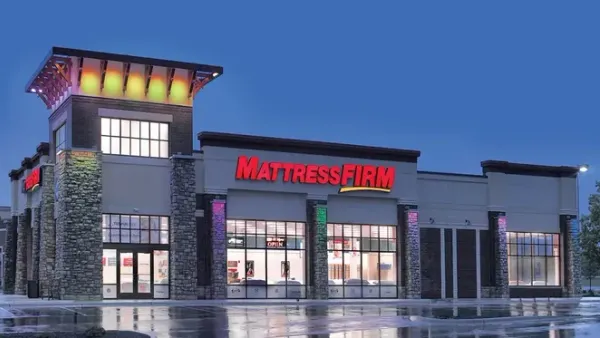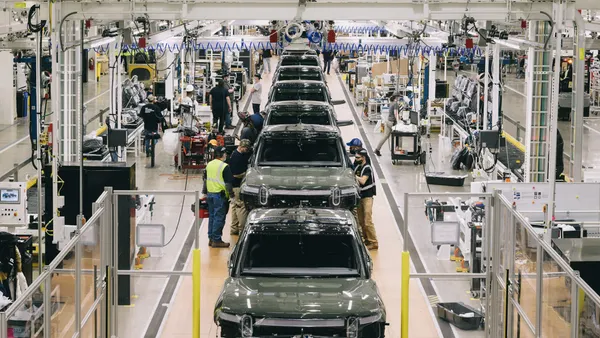Planting the seeds of a cannabis supply chain

Laurence Wolfe's resume includes supply chain stints at Heineken and Gartner. Now he’s the senior vice president of manufacturing and supply chain at Acreage Holdings, a cannabis company that's publicly traded in Canada and also has a U.S. footprint. Mike Beaudry spent time working as a supply chain executive for the food wholesaler United Natural Foods before helping to found the marijuana distribution company Herbl.
It's this kind of background in logistics and supply chain that many companies in the cannabis industry could benefit from, experts say. And as more states start to legalize marijuana, talent will be in even greater demand.
"We're hitting these hiccups because people don't necessarily ... even know that they need supply chain people," said Greg Huffaker, the director of client services at Canna Advisors. "They don't even know that they need expertise in this. And, you know, that's part of the problem."
The issue of how to begin a cannabis supply chain is sure to be on the minds of some businesses and residents in the four states that passed laws to legalize recreational marijuana in the Nov. 3 election: Arizona, Montana, New Jersey and South Dakota. They join 14 other states, territories and the District of Columbia that have already legalized marijuana, according to Norml.
As states have legalized in recent years, there seems to be a common theme of long-term shortages along with quickly selling out at the dispensary level when sales begin. Standing up an efficient supply chain is an important step in ensuring there is enough supply to meet the demand on opening day.
One of the first steps to creating a marijuana supply chain is understanding the regulations, experts said.
Understanding regulations
Regulations can vary substantially from state to state.
"For us, it always starts with the lens from a regulatory perspective and ensuring that, whatever market that we are going into, we understand that regulatory landscape. Compliance to the regulatory landscape is paramount in everything that we do," Wolfe said.
One of the first regulations a company will need to consider from a supply-chain perspective is if the state requires the company to have a fully integrated vertical supply chain from cultivation to retail. Florida is an example of a state that has required this, but it has been challenged in court by companies looking to open up the market for standalone licensing opportunities. New Jersey also requires that companies be vertically integrated, according to Huffaker.
Cannabis laws across the U.S.
Washington, meanwhile, is an example of the other model, according to Chase Towery, the COO of Cultivera.
The state has three major licensing sections: Producers or cultivators grow the plants, processors make edibles or other manufactured products (this license also includes wholesalers), and retailers sell product to consumers. In Washington, a business can have a producer license and/or a processor license but then can't have a retail license.
"There's this very clear separation," Towery said.
The big problem with the forced vertical is it's not very American, right?
This regulation will tell a company quite a lot about the structure of its supply chain from the get-go. The requirement to control a company from seed to sale is quite different that just running a dispensary, experts said. Standing up a vertical operation will require a lot more money and supply chain planning to move from one step to the next. The ability to invest in a single part of the supply chain — whether its manufacturing or retail — has a lower barrier to entry, if its allowed.
"The big problem with the forced vertical is it's not very American, right?" Huffaker said. "First of all, it's a very restricted form of business. And second of all, they're just not succeeding."
The selection of dispensaries is considered worse in states with mandated vertical operations, as the companies tend to focus on the products they're best at and can't bring in products from companies that specialize in other form factors, he said.
"It's a lot more regulatory hurdles that you're not used to," Huffaker said, comparing the cannabis business to other industries.
Cultivation: Planting the seed for growing operations
When a state legalizes marijuana, a company that wants to start cultivation can find itself in an interesting spot: Where does the first legal plant come from? Interstate commerce of marijuana is not allowed becuase it's still illegal at the federal level.
"Yeah, the immaculate conception question," Graham Farrar, the president at Glass House Group, a cannabis cultivator in California, said when asked about growers getting their first plants in the ground.
Farrar said people he's spoken with in the industry have funny stories about transporting clones into newly legal states like it's a salad. "And that salad is a cannabis plant," he said.
Growers can start their cultivation two ways: with seeds or a clone. The transportation of seeds is legal in the U.S., as they don't contain any THC, the active ingredient of cannabis. But there are problems with starting from seeds, Huffaker said.
"You're not sure what you're getting," he said. "You may be getting male and we're only interested in female cannabis plants."
The uncertainty surrounding seeds mean many cannabis businesses try to get their hands on a clone of an existing marijuana plant that produces product with which they know they'll be happy.
"From a legal standpoint, the clone appears in your facility magically and nobody asked questions," Huffaker said. "From a practical standpoint, it's being illegally brought across the line to that location. ... You can go to a dispensary here in Denver and you can buy clones, you can take those clones and stick them in a cooler and drive all night and get to where you want to go," he said. "That is federally illegal. I'm not condoning it, and I've never done it, and I never will. But if you're wondering how it ends up there, that's how it ends up there."
Clones can also come from the existing black market in any of the states that have recently legalized, so it doesn't always have to cross state lines, Huffaker said.
After a growing operating gets its seeds or clone, it needs to begin growing. This stage, as with all the stages, will also require turning to regulations.
"In certain states, and indeed, Massachusetts, you're capped at a certain level of canopy that you're allowed overall," Wolfe said.
Massachusetts' cultivation builds following legalization
And that canopy is going to need months to grow in its new home. Indoor growing facilities allow companies to crank out multiple lifecycles of a plant in a single year, but each still takes months to grow.
Reggie Reese, CEO and co-founder of The Green Toad Hemp Farm, the first hemp farm in Georgia (and so, the first Black-owned hemp farm in the state), recently transitioned to an indoor grow facility to help keep up with demand. Hemp, unlike marijuana, is legal in the United States at the federal level.
"Every two and a half months, we're pushing out enough product to meet the demand with the high-quality oil and the high quality smokeable," Reese said.
A growing period for a plant can range from 50 to 70 days depending on the strain, Wolfe said.
The manipulation of lights and nutrients within an indoor grow facility tricks the plant into thinking the year is shorter and results in it producing more flowers.
But the build up of supply doesn't just lie on the shoulders of farmers. The state also needs to have a basic understanding of growing time. The fact that plants need time to grow seems to be constantly forgotten by regulators, according to Huffaker, who said many states have allowed sales to begin too soon without allowing for enough cultivation time for plants to grow.

After it's grown, the plant has to be cured, which can take five to 15 days, according to Leafly.
Some of the plants will be used for smokable flower, but some will also go to manufacturing facilities, where they will be turned into other cannabis products.
Reese suggested that regulators ensure they provide enough cultivator licenses to help meet demand. Another bottleneck to meeting supply can be capping producers at a certain level and failing to raise this level when demand swells, Huffaker said.
"You look at a state like Michigan who [legalized recreational marijuana] at the end of last year," said Matt Hutchinson, the vice president and head of LeafLink Logistics. "They had serious supply problems, in terms of getting recreational flower to the market because a lot of the licenses hadn't gotten set up. So, they hadn't had a chance to get their cultivation facilities up and running."
Building the manufacturing pipeline
Manufacturing is the area where the marijuana supply chain can really start to get sticky, Huffaker said.
"Those manufacturing companies are like the nexus of supply chain headaches," he said.
In some cases, different companies handle cultivation and manufacturing, with a cultivator providing flower to a manufacturer, Huffaker said. But in others, such as Acreage's, manufacturing operations are connected to its cultivation facilities.
"Seldom do you cultivate in one location and bring it to another. That's just adding time into the supply chain process and some inefficiencies," Wolfe said.
Cannabis manufacturing companies also need to procure highly specific materials for manufacturing.
"Then they're putting that raw material into a closed-loop extraction machine that is using, generally butane or CO2, but yet another thing that you need to be obtaining from a separate supply chain," Huffaker said.
The output from the extraction will be what is known in the industry as "crude oil." To turn this into a usable product, a company has to put it through more processes, which could include using ethanol for a winterization process. So, the company now needs to find an ethanol supplier.
That comes after the manufacturing facility has a location. There are strict regulations around where these manufacturing facilities can locate because the closed-loop extraction process uses highly volatile chemicals, Huffaker said.
"Zoning, for the most part, doesn't allow explosive chemicals in many places," he said. "You get this issue that you might have a great idea and might be able to find product, but it might be tough to find a place to do it."
Seldom do you cultivate in one location and bring it to another. That's just adding time into the supply chain process and some inefficiencies.
Hardware can be hard to procure, too.
"A Midwestern state is only going to have so many centrifuges lying around," Huffaker said. "And if everybody's setting up at the same time, you know, that can get into a crunch very quickly."
And as if this wasn't enough bottlenecks to worry about, there is also packaging.
"There was a huge squeeze at the beginning of COVID across the country in manufacturing facilities because most of their packaging came from China," Huffaker said.
Most places have strict regulations around [putting cannabis products into child-proof containers, which means manufacturers "can't just go get a box from Office Depot," he said.
The companies developing a new pipeline will also need to consider the products they're making — flower, edibles or concentrates — and the strains they want to go into them. The manufacturing operation that is going to turn out the edibles and concentrates on a large scale will share many of the same principles, from a supply chain perspective, that are commonly known to CPG brands or life sciences, Wolfe said.
As with any market, an important part of ensuring that supply meets demand is understanding what the customers will want. At Acreage, the marketing team works to understand the consumer and patient preferences when it comes to the different cannabis products and then the supply chain works to build out a pipeline to meet demand, Wolfe said.
"We are looking to ensure that ... from a product perspective, back up the value chain, that we have both the products that meet that need, the different strains and genetics that goes into those products to meet that need, and that we have the capacity to support that," he said.
If all of this comes together and a manufacturing facility successfully acquires its chemical suppliers, its flower supplier, its location and packaging, then it will need to figure out how to get it to a dispensary.
Distribution: The lack of a mature market
"We can't ship anything via FedEx," Farrar said. "It has to be a licensed distributor."
In California, where Farrar is located, companies like Nabis and Herbl have popped up to help deliver products between the different legs of the cannabis supply chain. Nabis was started by two former software engineers who worked for Microsoft and Facebook, respectively. The top ranks of Herbl is full of executives who worked in more traditional supply chain spaces previously including UNFI and FedEx.
"We started out as delivery drivers for one of our friends who owned a preroll company," Nabis co-founder and CEO Vince Ning said in a video on the company's website. "And, as software engineers, figured that there was a huge area that needed to be improved upon around shipping and logistics for the cannabis space if it were to be scaled out as the projections say."
You are obligated with certain states that you have to control and own the outward distribution.
Not every state has a market of distribution options that is as mature as what's in California, though.
"It really helps businesses that are just starting out reduce their capital expenditures and their initial operational expenditures by not having to have a vehicle and have all the tracking software in it," Huffaker said.
This issue is that not every state creates a distributor license, so there's no legal way for a third party to move products from one place to another, he said.
"You are obligated with certain states that you have to control and own the outward distribution," Wolfe said. "In other markets, that's not the case."
This is why Acreage is not just a cultivator and manufacturer, but also a fleet owner, he said.

Track and trace, seed to sale
While the cannabis industry might not yet have a mature network of logistics providers, its visibility is arguably better than a lot of other agricultural supply chains. State laws require cannabis products be tracked from seed to sale.
The regulations for track and trace will differ from state to state. This is why Acreage, which operates in multiple states, has developed a track and trace system that attempts to be compliant with all of them by finding the lowest common denominator between the state regulations and building out a system from there, Wolfe said. This means keeping track of the plants DNA, growing stages and oils that are used.
Technology providers have materialized to meet the demand for track and trace solutions with Metrc being the biggest name in the space, according to multiple experts in the industry.
"One of our greenhouses probably has 300,000 plants in it. Every single one of those plants has an individual track and trace tag on it," Farrar said, adding that about five staff members are dedicated to just handling the track and trace side of Glass House Group's operation.
A plant is given a tag when it's planted and tracked through flowering. When the plants are harvested, the batch gets a tag and is tracked as it changes weight through the curing and trimming process. Then, packages are tracked down to an individual eighth of an once, Farrar said.
Every single one of those plants has an individual track and trace tag on it.
The tags have a barcode that can be scanned into the system. At each stage, the plant becomes associated with a new tag that will allow regulators to track the plant back to its days growing at a cultivator. Wolfe said the tagging system at Acreage is connected to the company's ERP system.
"So you can find a jar somewhere and you could scan it into the system and track it all the way back to the plant that we grew," he said. Getting there, though, isn't easy, he said, adding that, "I sometimes joke that we run a compliance business and sell cannabis on the side."
Though Huffaker said the implementation of track and trace is "less onerous than people think."
The system doesn't allow a supplier or retailer to see this level of visibility but provides the visibility to regulators when needed. If anyone gets sick from a product, state regulators can track it back to the plant, Huffaker said.
Some technologies have arisen to help get insight out of the data to provide for more understanding of internal operations. Cultivera helps companies to share sales data with their suppliers.
"We would like to know, 'well, how am I selling at that retail store?'" Towery said.












